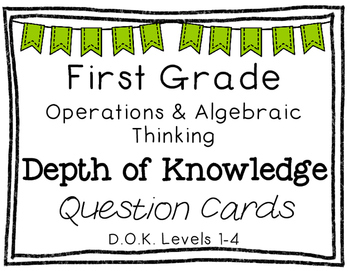First Grade Depth of Knowledge {DOK} Operations & Algebraic Thinking Questions
Little Lucy Tot School
322 Followers
Grade Levels
K - 2nd
Subjects
Resource Type
Standards
CCSS1.OA.A.1
CCSS1.OA.A.2
CCSS1.OA.B.3
CCSS1.OA.B.4
CCSS1.OA.C.5
Formats Included
- PDF
Pages
10 pages
Little Lucy Tot School
322 Followers
Also included in
- BUNDLE & SAVE!Get ready to challenge your students with this Depth of Knowledge {DOK} BUNDLE Question SetThis set includes Operations & Algebraic Thinking {OA}, Number & Operations in Base Ten {NBT}, Geometry, Graphing, Measurement, Telling Time, & FractionsThis set includes 176 totaPrice $17.90Original Price $27.00Save $9.10
Description
Get ready to challenge your students with this Depth of Knowledge {DOK} Operations & Algebraic Thinking {OA} Question Set
This set includes DOK levels 1-4
Level 1: 8 questions
Level 2: 8 questions
Level 3: 8 questions
Level 4: 8 questions
These are great for whole group, small group, or independent work for your students.
Enjoy!
Interested in more {DOK} math question sets? Check out this {BUNDLE} pack:
https://www.teacherspayteachers.com/Product/First-Grade-Depth-of-Knowledge-DOK-Math-Questions-BUNDLE-2622072
Total Pages
10 pages
Answer Key
N/A
Teaching Duration
N/A
Last updated Jul 2nd, 2016
Report this resource to TPT
Reported resources will be reviewed by our team. Report this resource to let us know if this resource violates TPT’s content guidelines.
Standards
to see state-specific standards (only available in the US).
CCSS1.OA.A.1
Use addition and subtraction within 20 to solve word problems involving situations of adding to, taking from, putting together, taking apart, and comparing, with unknowns in all positions, e.g., by using objects, drawings, and equations with a symbol for the unknown number to represent the problem.
CCSS1.OA.A.2
Solve word problems that call for addition of three whole numbers whose sum is less than or equal to 20, e.g., by using objects, drawings, and equations with a symbol for the unknown number to represent the problem.
CCSS1.OA.B.3
Apply properties of operations as strategies to add and subtract. If 8 + 3 = 11 is known, then 3 + 8 = 11 is also known. (Commutative property of addition.) To add 2 + 6 + 4, the second two numbers can be added to make a ten, so 2 + 6 + 4 = 2 + 10 = 12. (Associative property of addition.)
CCSS1.OA.B.4
Understand subtraction as an unknown-addend problem. For example, subtract 10 – 8 by finding the number that makes 10 when added to 8.
CCSS1.OA.C.5
Relate counting to addition and subtraction (e.g., by counting on 2 to add 2).






